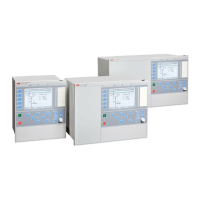either given in ohm/km and section length in km, or ohm/mile and section length in
miles. The resulting Flt distance matches the units entered for the line section lengths.
Positive-sequence impedance values
Fault location requires accurate setting values for line impedances. Positive-sequence
impedances are required both for location of short circuits and earth faults. As data
sheet impedance per unit values are generally valid only for a certain tower
configuration, the values should be adjusted according to the actual installation
configuration. This minimizes the fault location errors caused by inaccurate settings.
The positive-sequence reactance per unit and per phase can be calculated with a
following approximation equation which applies to symmetrically transposed three-
phase aluminium overhead lines without ground wires.
X
a
r
km
n
en
1
4
10 2 0 5≈ ⋅ ⋅ +
−
ω
ln . [ / ]Ω
GUID-B7F3697A-7C8E-4BF6-A63C-7BFD307DD128 V2 EN (Equation 59)
ω
n
2 × π × f
n
, where f
n
= fundamental frequency [Hz]
a
en
GUID-DA850ABF-239A-4AB5-B63B-F0B54557CF2E V2 EN
the geometric average of phase distances [m]
a
xy
distance [m] between phases x and y
r radius [m] for single conductor
GUID-40949A85-D97F-4639-9D61-3CAE997D28D3 V2 EN
Figure 255: Typical distribution line tower configurations
Example values of positive-sequence impedances for typical medium voltage
overhead-lines are given in the following tables.
Table 515: Positive-sequence impedance values for typical 11 kV conductors, “Flat” tower
configuration assumed
Name
R1 [Ω/km] X1 [Ω/km]
ACSR 50 SQ.mm 0.532 0.373
ACSR 500 SQ.mm 0.0725 0.270
1MRS758755 A Section 5
Protection related functions
REC615 and RER615 493
Technical Manual

